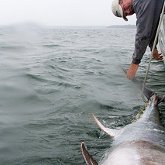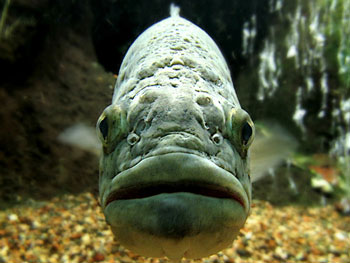Airasian Striped Bass Fishing Charter – 48 inch Striper!
August 8, 2009New Reel Additions for Fisherman's Outfitter
October 19, 2009Kite Fishing has been around for years now, yet not all fisherman are taking advantage to this exciting and new to some method of fishing.
The best way to picture how kite fishing works is to visualize how an outrigger works. You have a Separate Line with a Release Clip at the end, which takes you line away from the boat . When you get a bite from a fish the force gets transfered to the clip and your line is released.
The main items you will need to start kite fishing are:
1.) A Fishing Kite
2.) Kite Rod and Reel
3.) Release Clips
4.) Line to fly your kite
Many different styles of fishing have originated in the hopes of catching sailfish, sharks, and other top water game fish. Perhaps the most effective of these types of fishing is kite fishing. Kite Fishing is a technique of fishing that involves flying kites, and using the kites to suspend live baits on the top of the water. This type of fishing is highly effective for sport fishing off the coast of Ft. Lauderdale, where the Gulf Stream current and the natural reef running along the coastline, coincide. Sportfishing charter boats have been using this technique for 20 years to hook into the wide array of big game species that swim through our waters. This article is written in order to teach basic tactics on how to go about kite fishing. ?
For kite fishing, live bait is preferred. Start off by catching or buying live baits. Only certain types of baitfish will work effectively in the kite. These baitfish include Pogies, Mackerels, Bluefish and Herring. There are some other types of baitfish that can be used in the kite, but these types survive the best and produce the best results.
Start out by selecting your spot to fish. When kite fishing, you are mostly immobile. You will drift whichever way the current is moving, but as far as covering ground with your engines, you can only make small corrections. So first thing is to select a good area or depth of water to fish. Off the shore of Fort Lauderdale, one of the best areas is the 90’-120’ natural reef that runs along its coast. Other good areas are where there is a rip current, a temperature gradient, a color change or over the top of an artificial reef, such as a shipwreck. These are all good areas to begin fishing, and bear in mind that winds and currents will push you around a bit, so plan ahead.
Launch your kite from the highest point you can on your boat. If you are going to fly 2 kites simultaneously, you will want to put a small lead on the lower corners of each kite, depending on which direction you want each kite to spread to. The weight for this should be about 1/8 ounce for light kites and about ½ ounce for heavy kites. If weighted properly, the kites should spread apart from each other enough so that when the baits are out, the baits cannot get tangled together.
Your kites are flying now, and are about 50’-75’ off the back of your boat. Along your kite line, you should have a small barrel swivel tied every 40’ or so feet along your kite line. Use a snap swivel and attach your first kite clip to the kite line. You can buy these kite clips all made up for you at a bait and tackle store. Set the pressure of the clip release by tightening or loosening the setscrew on the clip. You want the clip to release with slightly more pressure than the baitfish will likely be able to put on it himself.
While the captain is launching the kites, the mate should be setting up the rods and baiting up. I like to sew my baits on with a wax line bridle. This gives you the most possible hook exposure and increases your hookup chances. Use a needle and sew the bait through the back of its neck, just behind the head of the fish. Don’t go too deep. About 1/4 of the baitfish’s body is as far as you want to stick that needle. Catch the loop of the wax line bridal on both sides with the hook and twist it up. Then stick the hook back underneath the entire bridal, making the hook tight to the body of the baitfish. Basically, the fish will be angled with his head up when he is dangling, forcing the baitfish to struggle to keep his head below water so he can breath. This will cause a lot of vibrations which is the desired effect when kite fishing.
OK, the baitfish is all baited and ready to launch. Hand the leader up to the captain to put through the pressure release clip. The captain snaps the line in, and begins to let the kite out away from the boat. The mate has to coordinate with the captain and let line out from the fishing rod at the same time. Once the bait is the desired distance from the boat, the mate must make constant adjustments to keep the bait right on the top of the water, struggling. The bait should be under the water, but the hook, leader and fishing line should all be out of the water. A lot of captains put a colored ribbon on the snap swivel of the fishing line, which is about 8’ out of the water, just above the bait. This helps visibility if there is a glare and the bait can’t be found at a quick glance.
When the big game fish comes up to feed, he will have to stick part of his body out of the water to get the bait. Indicators that you are about to get a bite are:
• The bait fish is going nuts and splashing more vigorously than normal
• You see splashes and “boils” on the top of the water around the bait
• You see a sailfish or shark fin out of the water next to the bait
• An unidentified dark spot under the water in the vicinity of the bait
• The pressure release clip just snapped and you don’t see anything
You will be alerted some way or another that you are about to, or just got a bite. The best thing to do when you get a bite is to free spool the fishing pole and let the big fish eat the bait and swallow it down. Wait till the big fish is taking line off quickly before you lock up and begin to wind to set the hook. This means that either the game fish is trying to swallow and wash the bait down his throat, or he has felt you and knows that something is wrong. In either case, lock up the rod into strike, tell the captain to “go ahead” with the boat, and start winding as fast as you can to get the slack out of the line. When you come tight, the line will pop out of the pressure release clip and there will be even more slack to take up. Keep winding until you come tight on the fish. When you come tight, set the hook with a couple gentle but firm tugs with the rod. This will hopefully set the hook into the fishes jaw.
Kite fishing is a very exciting way to hook into big game fish. You get to see the whole bite sequence and the hook up ratio is usually very high. It takes quite a bit of practice to become proficient with kite fishing technique. Keep trying though, it will pay off!


